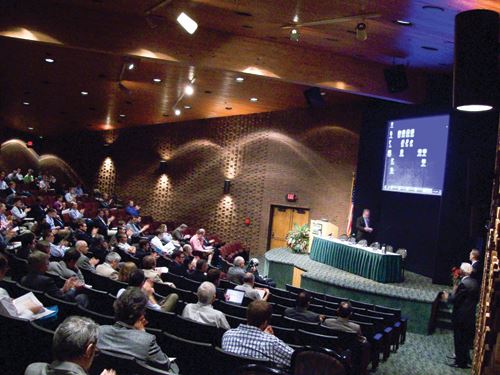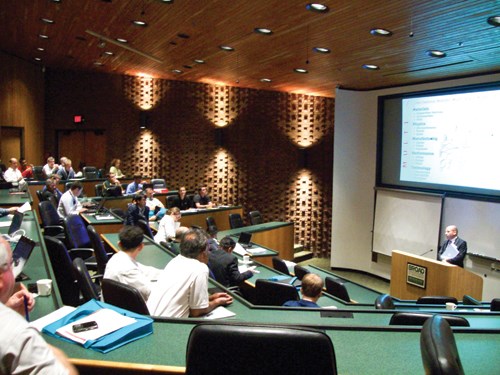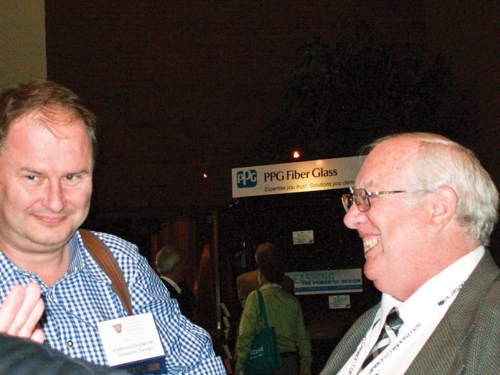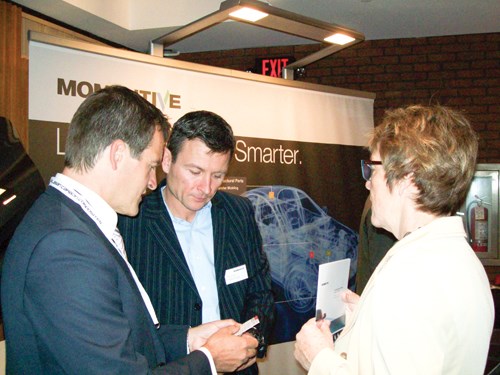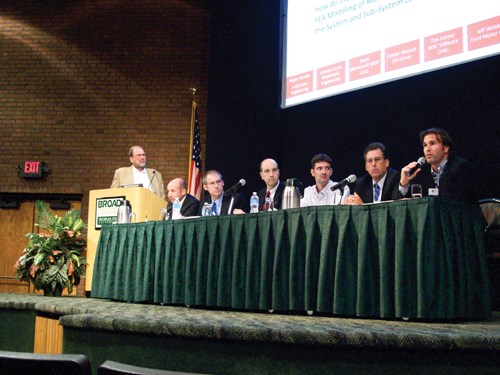SPE ACCE 2012 Review
Bursting at the seams, the 12th annual Society of Plastic Engineers Automotive Composites Conference and Exhibition tops its previous bests.
The 12th annual Society of Plastics Engineers (SPE) Automotive Composites Conference and Exhibition (ACCE), held Sept. 11-13, took on much more of the look and feel of an exhibition this year at the Michigan State University (MSU) Management Education Center (MEC) in Troy, Mich. ACCE organizers appropriated space historically used to accommodate the daily luncheons and opened those areas up to exhibitors. The luncheons were moved out to the MSU patio area in a massive tented space. The result was a substantial increase in exhibition area.
Conference organizers reported that the 2012 event broke the previous attendance record (504 in 2011) with 636 registrations — a 21 percent increase. Although that was good news, it was clear to SPE’s Automotive and Composites divisions that the MEC is no longer big enough to contain this growing automotive event. In a postevent announcement, SPE revealed that the 13th SPE ACCE will be held at the larger Diamond Center, in Novi, Mich.
Creig Bowland, a senior research associate at glass-fiber supplier PPG Industries Inc. (Pittsburgh, Pa.), who served as the conference chair last year, took another turn in that position for 2012, overseeing a slate of 70 peer-reviewed paper presentations, two panel discussions and five keynote speakers. And organizers also offered two postconference tours: one to the new Plasan Carbon Composites facility in nearby Wixom, and the other across the Canadian border to the new Fraunhofer Institute for Chemical Technology (ICT) (London, Ontario).
Preforms in the performance track
Preforms were a hot topic this year. Two full sessions were devoted to new technologies in this area. For example, Dan Buckley of American GFM Corp. (Chesapeake, Va.) highlighted his company’s light-curable binder, which reportedly cures in less than one second on simple, low-cost tooling. The light cure can be varied to selectively control stiffness where needed, and the preform can be combined with cores or with thermoplastic skins. He emphasized the importance of drapability, or, as he preferred, “conformability,” which is key to a successfully formed preform.
Lee Harper of Nottingham University (Nottingham, U.K.) discussed new work in producing carbon fiber preforms by spraying discontinuous fibers with binder, similar to Ford Motor Co.’s (Detroit, Mich.) P4 preforming method, originally developed in the early 1990s with Owens Corning Composite Solutions Business (Toledo, Ohio) and Aplicator System AB (Mölnlycke, Sweden). Harper and his research team have created a process simulation tool to help predict sprayed fiber preform performance and then optimize the method. They also have developed a way to orient fibers during the spray process yet maintain fast fiber throughput. The oriented preforms deliver the same stiffness as continuous unidirectional tow, with good strength retention, claims Harper. Other materials, such as fabrics, can be incorporated, offering a lower material cost option for molding high-performance structural parts.
Sigmatex’s (Benicia, Calif.) Jonah Jimenez discussed his company’s ability to weave custom preforms using a high-speed, three-dimensional Stäubli (Duncan, S.C.) Jacquard machine. Although he had to admit that the weaving process adds cost, Jimenez pointed out that material can be quickly and continuously produced in long rolls and in multiple shapes and fiber types at a price approaching that of 2-D fabrics.
Interest also was high in a paper presented by Tommy Fristedt of LayStitch Technologies (Highland, Mich.) on a tailored fiber placement technique that produces a flat preform in a process he likened to printing, using stitched carbon tows for local reinforcement. The company claims almost zero waste, because the preform can be stitched and layed down exactly as needed, and stitching can be selective for maximum conformability. The company’s products have been used by Airbus for aircraft window frames, and Fristedt believes the low cost and improved speed, as well as the ability to incorporate electronic wires, for example, can yield cost-effective preforms for automotive applications.
The virtues of virtual engineering
The conference theme, “Unleashing the Power of Design,” was best exemplified by the four sessions devoted to “Virtual Prototyping and Testing of Composites.” Fifteen speakers outlined the state of virtual design and development, and they explored both the strengths and remaining limitations of software-based modeling and testing that reduce or eliminate the need for expensive iterative make-it-and-break-it development cycles.
Dr. Mike Wyzgoski, a consultant to the American Chemistry Council (ACC), led off the sessions with an encouraging report that set the tone for the others as he described ACC-enabled initiatives to apply “predictive engineering” to long-fiber reinforced thermoplastics. Wyzgoski emphasized the role of time in the progress of virtual engineering. Short-fiber thermoplastics, now a staple in the auto industry, are well characterized, he noted, but long-fiber thermoplastics, a comparatively new approach, simply haven’t had the history yet that permits those who write and use the software to build the mathematical models necessary to simulate part performance and render predictions of actual performance that are accurate and reliable.
ACC is “building bridges” between the U.S. Department of Energy (DoE), Oak Ridge National Laboratory (ORNL, Oak Ridge, Tenn.) and others to expedite the mathematical modeling process. He reported that the work is close to producing commercially applicable software. In one project, for example, researchers in a study called “Engineering Property Prediction Tools for Tailored Polymer Composite Structures” — funded by the DoE, ORNL and Pacific Northwest National Laboratory (PNNL, Richland, Wash.) — combined forces with software writers from Autodesk Inc. (San Rafael, Calif.) to develop models for predicting the extent of breakage during compounding and injection and the final fiber length in the part. Autodesk is now negotiating to incorporate the fiber length prediction models into its AMSA Mold Flow software.
Wyzgoski outlined a number of other active efforts toward these ends that should soon bear fruit, noting that ACC sees its job as shaking the tree. “We’ve tried to plug gaps not covered by government funding,” he explains, noting that the ACC is “helping arrange funding and coordination for case studies of actual three-dimensional parts.”
Shortening the thermoset cure cycle
Also much discussed were advances in thermoset chemistries aimed at rapid processing. Roman Hillermeier of Momentive Specialty Chemicals GmbH (Iserlohn, Germany) discussed a way to accelerate structural part cure with a new-generation epoxy resin formulated with a latent short cycle; the resin cures in five minutes but maintains a lower viscosity for a four-times longer resin injection window in a gap impregnation resin transfer molding (RTM) process while delivering a higher Tg and a Class A finish. The new Momentive EPIKOTE resin (with EPIKURE curing agent), intended for carbon fiber automotive parts and at least 50 percent fiber volume, is aimed at automated, high-volume production. At the show, the company also offered an even faster-curing epoxy, EPIKOTE Resin 05475. Its two-minute cure cycle still allows for complete fiber wetting and mold fill, and it delivers good mechanical properties in the finished part.
R&D on high-pressure RTM
A related area of high interest was the series of speakers involved in R&D on increasing the injection speed in RTM processes to satisfy OEM automotive production rates. Raman Chaudhari, from the Fraunhofer-Institut für Chemische Technologie (ICT, Pfinztal, Germany), presented the results of his Ph.D research on the subject of high-pressure RTM. Noting from the outset that the process “isn’t ready for prime time,” he identified three process aspects that still need work: the preforming process, the injection sequence and the cure cycle. The high pressure and high resin-flow rate displace fibers in the preform, and the length of time needed to wet out the preform precludes the use of available fast-cure resins. A process variant, high-pressure compression RTM, leaves a gap between the preform and upper tool, permitting the resin to flow over the preform’s top surface. The mold closes after the preform is covered and forces the resin into the preform while it consolidates the laminate. In tests, this method reduced injection time from 30 seconds to 7.5 seconds.
Another presenter, Dr. Lolei Karine Kohun of the National Research Council Canada (Ottawa, Ontario), reported that her research, which compared high-pressure RTM (HP RTM) and high-pressure compression RTM, resulted in an even faster injection time for the latter. Using injection pressures from 6 to 15 MPa, compared to about 1 MPa for conventional RTM; a quadraxial noncrimp fabric in the preform, with up to 6 percent binder to prevent fiber wash; a Voraforce epoxy resin (Dow Automotive Systems, Midland, Mich.) formulated to withstand 300°C/572°F temperatures; and a mold temperature of 100°C/212°F to reduce the resin viscosity and accelerate cure, the injection time was one minute, with complete cure in five minutes. Further, the compression RTM alternative showed little degradation in mechanical properties at increasingly faster cycle times, while an HP RTM process without the compression feature exhibited a definite downtrend in properties as injection speeds increased. The downtrend was attributed to the higher percentage of binder required to prevent fiber wash in HP RTM. The binder interrupted resin flow, creating voids. Experiments with vacuum assistance and reduced binder content, however, improved properties.
A vision for visionary design
Great advances are almost always the result of what pundits like to call “disruptive technologies.” ACCE had what one might characterize as a disruptive keynote speaker. Oliver Kuttner, CEO and co-owner of start-up automaker Edison2 (Lynchburg, Va.), spoke on the less than self-explanatory subject of “Correct Primary Decisions Leading to Positive Feedback Loops.” What conference-goers got, however, was memorable: not just a challenge to think outside the box, but a clear and kindly call to be done with the box and start over. Kuttner noted that many ACCE participants were addressing issues raised by the recently solidified new CAFE standard (54.5 mpge), and he asked how many in the auditorium were aware of the impending European carbon dioxide (CO2) standards, slated for enactment in 2016. Few raised their hands. CAFE standards, he said, are both footprint dependent (that is, the standard is eased for larger vehicles) and escapable (auto OEMs can draw a bye simply by paying the per-vehicle fine). Kuttner assumed that some automakers would simply consider it a cost of doing business to pay fines rather than comply. For that reason, he contended, the CO2 standard is the real worry. It is nonnegotiable and absolute, and it will have to be met. He doubted that current lightweighting efforts would get automakers into compliance. “Trim here, trim there, will not be enough,” he warned. “And even if we do all that trimming, and it costs a fortune, and even if we get there, what do we do after that? We’ve exhausted all options. At some point, there’s nowhere to go.”
Kuttner proposed, based on his experience as the winner of the recent Progressive Insurance Automotive X Prize with a vehicle that averaged more than 100 mpge, that the alternative for auto OEMs is to fundamentally reinvent the automobile and quickly produce an extremely fuel-efficient car as a niche vehicle (as few as 4,000 units). This would buy margin in the OEM’s CAFE average, he argued, and the lessons learned would inform efforts to meet inflexible CO2 regulations. Four years ago, he and his team set out to do just that. Despite the fact that 65 cars were entered into the X Prize competition, he claimed that only two made the finals — both were his.
Kuttner showed off a 50-lb/22.7-kg front suspension assembly developed for his winning cars. Noting that one of the talking points at the conference was the expense of dealing with coefficient of thermal expansion (CTE) mismatches and other issues at “connection points” where composites meet metal, he pointed out that the assembly has only two attachment points to the body in white. All the suspension is in the wheel. Eliminating the strut tower, he explained, opens up the auto interior. The suspension system, reportedly proven in 24-hour rally racing under brutal conditions, marked the “first domino to fall,” Kuttner claims, in a long series of rethinking and reworking steps that led to a car that could, with a steel frame, get 129 mpge. And Kuttner told attendees that each of these technologies are for sale.
He challenged automakers to think not only about next year’s model, but a model for the next decade. He suggested they envision a car, for example, whose owner (or, potentially, time renter) plugs in a personal tablet computer that interlocks with the cars ignition (thus preventing theft) and diagnostic systems and also displays data once read from now absent dashboard gauges. Kuttner called for a radical rethinking of how to combine technologies in like manner to avoid duplication and thereby save significant cost.
Multi-material vehicles: No minced words
Immediately following Kuttner’s keynote address, he and five others assembled on the dais for the first — and most lively — of two panel discussions on the subject of the “Multi-Material Vehicle.” Moderator Lindsay Brooke, senior editor of Automotive Engineering Magazine (SAE International, Warrendale, Pa.), questioned panelists on the subject of Design and Assembly. The panelists included Kuttner; Saad Abouzahr, senior manager, materials engineering, at Chrysler Group LLC (Auburn Hills, Mich.); Dr. Antony Dodworth, managing director at Dodworth Design (Birmingham, U.K.); Dr. Jay Baron, president, CEO and chairman of the board of the not-for-profit Center for Automotive Research (CAR, Ann Arbor, Mich.); Gary Lownsdale, director of R&D and engineering at Plasan Carbon Composites (Bennington, Vt.); Tom Pilette, VP of product and process development for Magna Exteriors (Troy, Mich.); and Dr. George Ritter, technology director at the Edison Welding Institute (EWI, Columbus, Ohio).
When asked to define the term “multi-material car,” Abouzahr, Dodworth and Baron pointed first to autos as we know them. Steel has, to some extent, been replaced by aluminum, plastics and composites. However, Abouzahr noted that the challenge ahead is to replace steel with lighter materials in the body in white, calling it “the last frontier.” Dodworth noted that the new Porsche has seven materials, and the Audi A2 sports 23 kg/50.7 lb of carbon fiber composites. Baron pointed out that the challenge, going forward, is the CTE differences between materials that must be joined and then painted. Kuttner agreed, noting that vastly reducing the number of connecting points through redesign of the vehicle architecture will be a key to multi-material compatibility. He envisioned a radical re-engineering of the automobile that will launch a “golden age” to come. Lownsdale noted that sports cars, such as GM’s Chevrolet Corvette and Chrysler’s Dodge Viper, have been multi-materials showcases for years. He pointed out that weight reduction, in fact, has been a recurring theme since the 1960s and noted that each time the topic came up, joinery was an issue. He recalled his work on early Saturns, which incorporated thermoplastic fenders and door panels on an otherwise steel body, and fasteners were the critical factor. Agreeing with Kuttner, Lownsdale predicted, “In this decade, materials and architecture will both count.” Ritter, a joinery expert, agreed that joints are critical and noted that the EWI “phone is ringing” already with requests for assistance on joinery issues.
When Brooke broached the subject of recent partnerships of OEMs with carbon fiber producers, Abouzahr noted the reluctance he saw firsthand at Chrysler when early composites efforts didn’t work, recalling one time when he suggested a plastic engine manifold at a meeting only to be asked to leave. He recalled a time when an RTM process proved unready and a part was made, instead, from aluminum. He noted that today the OEM still does not know composites technology and is reaching out to those who do. Baron pointed out that most OEMs are staffed by mechanical engineers, not chemical engineers, who know little about resins and other subcomponents of composites. “So this is a barrier. You need to get the steel, aluminum and composite people together — not working separately but together to bring all the material options into the fold,” he said, adding, “Obviously, the government will have take a big part in that.” It will require, he added, “all kinds of cooperative efforts. There is no one solution. You have to find compatible people who can come together and work on this.”
Lownsdale saw, in that, the need for education. “You have to spend time conveying what you’ve learned to the engineers who actually do the work,” he said, insisting, “Mechanical engineers can understand polymers!” He argued that they would, in fact, bring to the discussion a fresh perspective. “They approach material differently than chemical engineers,” he said, but contended, “That’s an advantage, thinking about the material mechanics on a chemical level.” As automakers combine materials into a subsystem, he predicted that “cross-pollination” will create a knowledge base that could extend back to the design engineer. That, he said, is “the only way it will work.”
Fireworks were lit, however, when Abouzahr suggested that proponents of structural and Class A auto composites still bear the burden of proof that composites and composite molding processes can indeed produce parts of sufficient quality fast enough to meet OEM expectations and be adaptable to OEM paint lines. Until then, he said, OEMs are unlikely to make a wholesale commitment. Lownsdale took strenuous objection to that characterization, noting that his own company has a very cordial and close relationship with his company’s Viper program and has already demonstrated technology sufficient to satisfy those demands. He pointed out that Plasan has a 17-minute (layup to primed part) production process in place and is close to a shorter 11-minute process. He claimed that it is possible to mold the part in as few as two minutes, noting that when other steps of the process (not directly composites-related) catch up with that, the entire process can be downsized time-wise to incorporate the shorter mold cycle.
Baron made a cogent point, however, when he contended, “The best part is no part.” He went on to explain that innovative part consolidation is a huge benefit offered by composite materials. Fewer parts overall vastly reduces the time and the number of discrete steps and critical joints necessary to produce them.
Carbon fiber supply & demand, revisited
As always at such events, the panelists were asked a perennial question: As aerospace programs consume increasing quantities of carbon fiber, will there be enough supply for automakers? Ritter noted that the opportunity for significant carbon fiber use is greater than ever before. Although the steel industry has been aggressive in designing alloys that can be made thinner, Ritter noted that strategy can only go so far. Lownsdale applauded the recent alliances and partnerships that virtually every automotive OEM has made with a carbon fiber producer to ensure its supply. And, he added, what is really happening at this point is judicious use of smaller quantities of carbon fiber where needed — not entire bodies.
Elsewhere during the event, ORNL’s Cliff Eberle discussed his organization’s efforts to develop alternative carbon precursors, including lignin and polyolefin. The lab’s new carbon fiber line is slated to open in February 2013. And presenter George Husman of Zoltek Corporation (St. Louis, Mo.) asserted that most molders are struggling with process — that is, finding the most effective and efficient way to make carbon parts. He believes that a carbon fiber-filled sheet molding compound (SMC) shows much promise, because of its lower density than glass at the same fiber content, and he said that thinner parts are possible with carbon fiber. He also discussed the use of unidirectional continuous fibers in selective reinforcement of a low-cost, injection molded part. “We need more creative design for manufacturing,” Husman summed up.
Related Content
GKN Aerospace, Joby Aviation sign aerostructures agreement
GKN Aerospace will manufacture thermoplastic composite flight control surfaces for Joby’s all-electric, four-passenger, composites-intensive ride-sharing aircraft.
Read MoreNovel composite technology replaces welded joints in tubular structures
The Tree Composites TC-joint replaces traditional welding in jacket foundations for offshore wind turbine generator applications, advancing the world’s quest for fast, sustainable energy deployment.
Read MoreCOMPINNOV TP2 project promotes use of thermoplastics in aerospace
Completed in 2023, COMPINNOV TP2 explored thermoplastic composites, enhancing the understanding between prepregs and production methods to foster the potential for French aerospace innovation.
Read MoreCompPair adds swift prepreg line to HealTech Standard product family
The HealTech Standard product family from CompPair has been expanded with the addition of CS02, a swift prepreg line.
Read MoreRead Next
VIDEO: High-volume processing for fiberglass components
Cannon Ergos, a company specializing in high-ton presses and equipment for composites fabrication and plastics processing, displayed automotive and industrial components at CAMX 2024.
Read MoreDeveloping bonded composite repair for ships, offshore units
Bureau Veritas and industry partners issue guidelines and pave the way for certification via StrengthBond Offshore project.
Read MoreAll-recycled, needle-punched nonwoven CFRP slashes carbon footprint of Formula 2 seat
Dallara and Tenowo collaborate to produce a race-ready Formula 2 seat using recycled carbon fiber, reducing CO2 emissions by 97.5% compared to virgin materials.
Read More
